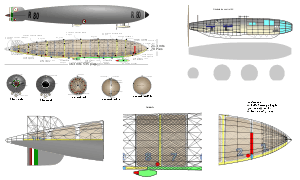R80 (airship)
| R80 | |
|---|---|
 | |
| Role | Airliner |
| National origin | United Kingdom |
| Manufacturer | Vickers |
| First flight | 19 July 1920 |
| Number built | 1 |
|
| |
The R80 was a British rigid airship, first flown on 19 July 1920 and the first fully streamlined airship to be built in Britain. Originally a military project for the British Admiralty, it was completed for commercial passenger-carrying purposes. R80 proved too small for this role and after being used briefly to train the United States Navy personnel who were to crew the ill-fated ZR-2 airship, R80 was retired and eventually scrapped in 1925.
Development
Construction was began by Vickers in their airship shed at Walney Island, Barrow-in-Furness, in November 1917 to a design by Barnes Wallis and H. B. Pratt. Vickers had originally contracted to build R37, but due to a lack of vacant sheds and a war-time steel shortage preventing construction of a new larger one, the smaller shed at Walney was used instead. This had been used to build R27 and R29, and the size of the R80 was limited by the small size of the shed.
Work progressed slowly due to labour shortages, and with the end of the First World War, the future of military airships was reviewed. The Air Ministry stopped the work in the summer of 1919 as it was considered that the ship was no longer of military or commercial value. Vickers continued to fit out the ship with commercial objectives in mind but the scheme fell through. Co-designer H. B. Pratt completed a report envisaging an intercity European flight route, similar to that being run by the Zeppelin company:
"The route chosen to Rome is 1,000 land miles which is within the endurance of the ship. It is expected that the ship will fly at a maximum height of 2,000 ft. The route will carry the ship over south England, the over the English Channel to Paris on a direct route. The ship will then deliver mail and passengers, and then pass down in a continued south easterly direction towards Lyon. Passing over Lyon, the ship will turn south through the Rhone Valley and the continue to Nice. At Nice on the French Coast, the ship will turn easterly and skirt the coast and head towards Rome over the sea. The return course will be via the same route."
Operational history
In April 1920, the outer cover was completed and by June the ship was finished. On 19 July, the ship emerged from its shed for its first flight. The ship was damaged on the trial flight as the ship had not been properly ballasted, and the lifting gas heated causing the ship to rise too fast. The result was extensive buckling of the framework. The ship was returned to its shed to be repaired, which took until January 1921. After further test flights the airship flew to the airship station at Howden, East Yorkshire in February where it was used for training the United States personnel who would crew the R38 (ZR-2). The US Navy made 4 flights in the ship totalling some 8 hours 45 minutes between 26 March 1921 and 1 June 1921.
After these flights, it was flown to RNAS Pulham, Norfolk. There the airframe was used for stress analysis and destructive testing before being dismantled in 1925. In total, this relatively small but well designed craft flew for only 73 hours.
Although successful in trials the design was too small for the intended use. Many lessons were learnt and incorporated in the design for the R100. One of the lasting innovations introduced by Barnes Wallis during construction was the first use ever of colour-coded wiring for the electrical systems of an aircraft.
Specifications
Data from
General characteristics
- Length: 535 ft 0 in (163 m)
- Height: 70 ft 0 in (21 m)
- Volume: 1,260,000 ft3 (35,700 m3)
- Gross weight: 85,680 lb (38,950 kg)
- Useful lift: 33,260 lb (15,100 kg)
- Powerplant: 4 × Wolseley-built Maybach engines (Maybach Mb.IVa), 240 hp (180 kW) each
Performance
- Maximum speed: 70 mph (113 km/h)
References
- Griehl, Manfred and Dressel, Joachim Zeppelin! The German Airship Story. 1990 ISBN 1-85409-045-3
- Morpurgo, J. E. Barnes Wallis - A Biography. London: Longman, 1972 ISBN 0-582-10360-6
- Mowthorpe, Ces Battlebags: British Airships of the First World War. 1995 ISBN 0-905778-13-8
- Swinfield, John. Airship: Design, Development and Disaster. London: Conway, 2012. ISBN 978-1-84486-138-5
- Lord Ventry and Eugene Kolesnik, Jane's Pocket Book 7 - Airship Development, 1976 ISBN 0-356-04656-7
- Lord Ventry and Eugene Kolesnik, Airship saga: The history of airships seen through the eyes of the men who designed, built, and flew them . 1982, ISBN 0-7137-1001-2
External links
| Wikimedia Commons has media related to Vickers aircraft. |